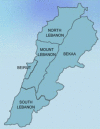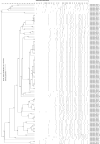Epidemiology, clinical manifestations, and molecular typing of salmonella typhi isolated from patients with typhoid fever in Lebanon
- PMID: 25922325
- PMCID: PMC7320491
- DOI: 10.1016/j.jegh.2014.07.003
Epidemiology, clinical manifestations, and molecular typing of salmonella typhi isolated from patients with typhoid fever in Lebanon
Abstract
The objective of this study was to examine the epidemiology and the clinical manifestations of typhoid fever as well as the susceptibility and strain relatedness of Salmonella typhi isolates in Lebanon from 2006 to 2007. A total of 120 patients with typhoid fever were initially identified from various areas of the country based on positive culture results for S. typhi from blood, urine, stools, bone marrow and/or positive serology. Clinical, microbiological and molecular analysis was performed on cases with complete data available. These results indicated that drinking water was an unlikely mode of transmission of the infection. Despite increasing reports of antimicrobial resistance among S. typhi isolates, the vast majority of these isolates were susceptible to various antibiotic agents, including ampicillin, cephalosporins, quinolones, and trimethoprim/sulfamethoxazole. Molecular analysis of the isolates revealed a predominance of one single genotype with no variation in distribution across the geographical regions.
Keywords: Enteric fever; Food borne diseases; Middle east; Molecular typing; Salmonella typhi; Typhoid fever.
Copyright © 2014 Ministry of Health, Saudi Arabia. Published by Elsevier Ltd. All rights reserved.
Conflict of interest statement
No competing interest to declare.
Figures




References
Publication types
MeSH terms
LinkOut - more resources
Full Text Sources
Other Literature Sources
